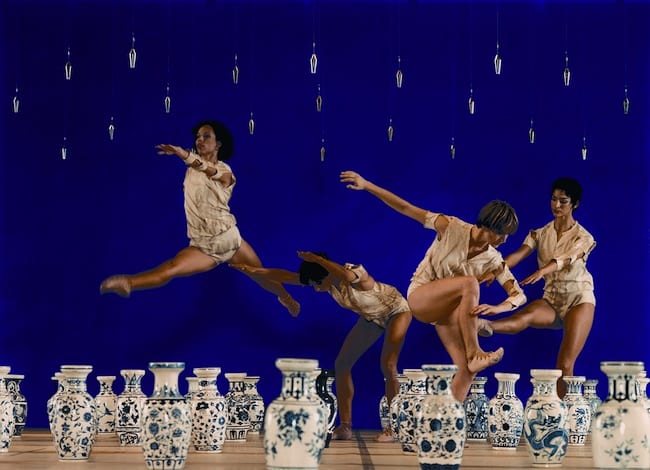One is never sure when the next cluster of blue and white pottery will strike. We have already encountered it on Valentino’s catwalk in Paris. In a few weeks we’ll post about how blue and white emerged from a sugar factory, but for now let’s talk about how blue and white are haunting contemporary dance. It is one of the most imaginative sets I have encountered but at the same time it is one of the most constricting situations for dancers as they perform in a minefield of crockery.
The Brazilian choreographer Deborah Colker and her company Companhia de Dança Deborah Colker in Rio De Janeiro are known for their imaginative settings. Her theatricality has earned her both praise and brickbats from dance critics. She did not win any brownie points from the purists when she became the first woman hired to direct a Cirque du Soleil show.
My most memorable encounter with her company was Vasos, one of the scenes from a full length dance work entitled 4 Por 4. It begins with 90 blue and white vases descending onto the stage in a symmetrical grid. The device that holds them, resembling the conical end of a plumb line, is attached to a cable. The device magically releases once the vases reach terra firma and then it rises out of sight. The sight is so stunning under soft blue lighting that the audience always gasps. The set was by Colker’s regular collaborator Gringo Cardia and the vases were painted by Clécio Régime.
Meghan Frederick writing in iDanz Critix Corner explains what happens next:
“The men crawl and flip through the rows of vases, sometimes rolling backwards on diagonals that allow them to travel between vases, sometimes lifting their hips over and around the top of a vase, grazing it as they fly by. The women kick and turn, at one point executing coupe jetes over the vases, finding just the right height to land between them. The partnering here is pretty spectacular, men spinning and lifting women, bouncing them through the minefield, suspended lifts timed perfectly to create geometrical patterns.”
At the end they perform a reverse limbo dance under the vases as the cables descend, the metal devices enter the vases and magically reconnect (I suspect the system involves electromagnets). The lines carry the vases up and away. This also means the dancers cannot even nudge the vases a few inches off their grid. In the accompanying video one sees a dancer readjusting the position of a vase as subtly as he can.
Some critics had difficulty with the set including Frederick:
“I am literally on the edge of my seat at some points, but after the first few breath-holding moments, I continue to want more. I want to see the movement change, to get faster or slower, really huge or miniscule, or for the dancers to find some emotional reason for connecting with the movement itself. Even when the vases are gradually floated out on flies that had descended from the ceiling (an easy metaphor for transcendence) I feel nothing but relief -for now, those poor dancers can really move.”
I disagree. The point of vases is the acceptance of tense limitations, like watching a dance on the head of a pin. It is all played out in nuances. It addresses not just limited space but with consequence (a smashed vase or two) should a dancer not adhere perfectly to their boundaries. While the notion of pots being broken or being at risk is depressingly ubiquitous in performing arts (particularly in film) the resulting claustrophobia is powerful and necessarily discomforting.
Garth Clark is the Chief Editor of CFile
Above image: Companhia de Dança Deborah Colker, Vasos, one of the scenes from a full length dance work entitled 4 Por 4. Choreography by Deborah Colker, sets by Gringo Cardia and vases painted by Clécio Régime.
Any thoughts about this post? Share yours in the comment box below.
Video of 4 Por 4 by Deborah Colker. Vasos begins at 2:34. Video courtesy of Jocemar Filho.







Companhia de Dança Deborah Colker, Vasos.
Visit Deborah Colker Dance Company

Add your valued opinion to this post.